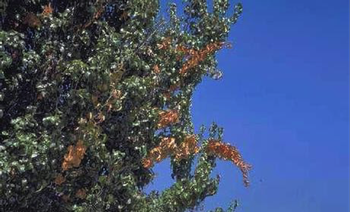Fire Blight
-
AboutFire blight is a common and frequently destructive disease of pome fruit trees and related plants. The disease can destroy limbs and even entire shrubs or trees. Caused by the bacterium Erwinia amylovora. Pear (Pyrus species) and quince (Cydonia) are extremely susceptible. Apple, crabapple (Malus species), and firethorns (Pyracantha species) also are frequently damaged. Less common on hawthorn (Crataegus species), Spiraea, Cotoneaster, toyon (Photinia species), juneberry or serviceberry (Amelanchier species), loquat (Eriobotria), mountain ash (Sorbus species), and other related plants. Infections can extend into scaffold limbs, trunks, or root systems and can kill highly susceptible hosts. Less susceptible varieties might be severely disfigured. Once infected, the plant will harbor the pathogen indefinitely.The amount of fruit loss depends upon the extent and severity of the disease.
 Photo: UC ANR
Photo: UC ANR -
Category
-
Bacteria
-
-
Signs/Symptoms
Watery, light tan bacterial ooze that exudes from cankers (small to large areas of dead bark that the pathogen killed during previous seasons) on branches, twigs, or trunks. Ooze turns dark after exposure to air, leaving streaks on branches or trunks.
Most cankers are small and inconspicuous; infections might not be noticed until later in spring when flowers, shoots, and/or young fruit shrivel and blacken. Infected flowers and flower stems wilt and turn black on pear trees and brown on apple trees. Infections might be localized, affecting only the flowers or flower clusters, or they might extend into the twigs and branches, causing small shoots to wilt and form a crook at the end of each infected shoot. Dead, blackened leaves and fruit cling to branches throughout the season, giving the tree a scorched appearance, hence the name “fire blight.” Newly infected wood underneath the bark has pink to orange-red streaks.
-
Where
Open flowers are the most common infection sites and remain susceptible until petal fall. Injuries on tender young leaves and shoots, caused by wind, hail, or insect punctures, are easily invaded by the fire blight bacteria.
-
When
Rainy or humid weather with daytime temperatures from 75° to 85°F, especially when night temperatures stay above 55°F. In spring, branch and trunk canker symptoms can appear as soon as trees begin active growth. Bacteria overwinter in cankers on twigs, branches, or trunks of host trees. Splashing rain or insects transmit the bacteria to nearby blossoms or succulent growing shoots. Once blossoms are contaminated with the bacteria, honeybees become efficient carriers of the pathogen.
-
Prevent
Choose plant varieties that are less susceptible to fire blight, e.g., ‘Bradford’, ‘Capitol’, and ‘Red Spire’ pear.
-
Manage
Remove infected parts of the plant in summer or winter when the bacteria no longer are spreading through the tree. Rapidly advancing infections on very susceptible trees should be removed as soon as they appear in spring, dipping shears in 10% bleach between cuts might be wise. To locate the correct cutting site, find the lower edge of the visible infection in the branch, trace that infected branch back to its point of attachment, and cut at the next branch juncture down without harming the branch collar. This will remove the infected branch and the branch to which it is attached. Infection that occurs on a trunk or major limb, wood often can be saved by scraping off the bark down to the cambium layer in infected areas (i.e., removing both the outer and inner bark). When scraping, look for long, narrow infections that can extend beyond the margin of the canker or infection site. If any are detected, remove all discolored tissue plus six to eight inches more beyond the infection. This procedure is best done in winter when trees are dormant, and bacteria aren’t active in the tree. Don’t apply any dressing to the wound. If the limb has been girdled, scraping won’t work, and the whole limb must be removed.
-
More Information

